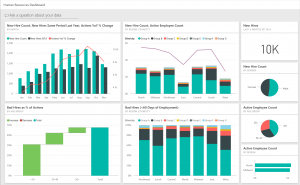
The progressive adoption of Business Intelligence (BI) systems allowed companies to implement their decisional processes, by putting corporate data resources into service of analysts and managers.
In addition to more traditional BI applications, such as those used in sales, production, or marketing department, it is possible to apply corporate data to the Human Resources area, with the aim of improving its productivity, process efficiency and selection systems effectiveness.
HR department undertakes several responsibilities within the company, in which data can play a key role if exploited to optimise decisional processes.
Let’s see how Business Intelligence can help achieve these goals.
Sommario
Work scheduling
Thanks to BI tools, it is possible to analyse trends within company’s workforce and try to anticipate future changes. Through reports it is actually possible to monitor metrics related to size-number of staff, turnover and employees’ distribution in terms of geographic position, age, qualifications and much more. Thanks to such data, planning and recruiting processes can be optimized, by improving the existing strategies or experimenting new ones. More advanced tools allow to simulate different scenarios, giving a more realistic representation of what might be in store.
Processes Improvement
One of the most direct benefits of BI is to slim inefficient processes down. Thanks to constant KPIs monitoring, it is indeed possible to directly compare HR department processes with reference benchmarks, both internal and external. As a result, strengths and weaknesses within the HR processes are detected and appropriate measures can be taken.
Talent Management
Talent and competences of a company’s staff management can be handled more profitably thanks to a data-driven approach. For instance, through BI reports it is possible to evaluate the recruiting process more effectively, measure the training programs performance and assess the skills developed by employees for addressing them to new roles or ensuring a continued growth in current ones.
Goals Alignement
A further benefit offered by BI is the chance to ensure that each department’s activity is in line with the company’s strategic goals. This translates for the HR department in the opportunity of working more cohesively and synergically, by monitoring each project’s and employee’s KPIs, along with realigning staff resources for the achievement of the goals set.
Conclusion
Business Intelligence is henceforth a key tool for developing a business a data-centred strategy.
Although many companies are already employing BI in different area and have already begun to experience its benefits, Human Resources department may not have taken advantage of it. This could be due to the fact that the area is seen as a source of costs rather than a value source by the management. Business Intelligence can help in overturning this view and turning HR departments in a strategic asset, exploitable for achieving the company’s goals.
Whether you have any inquiry about Business Intelligence technologies and their deployment, please contact us.
Comments are closed.






